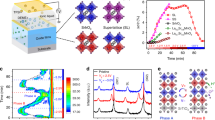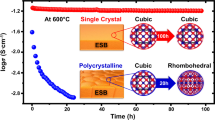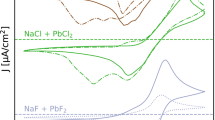Abstract
Electrochemical equilibrium and the transfer of mass and charge through interfaces at the atomic scale are of fundamental importance for the microscopic understanding of elementary physicochemical processes. Approaching atomic dimensions, phase instabilities and instrumentation limits restrict the resolution. Here we show an ultimate lateral, mass and charge resolution during electrochemical Ag phase formation at the surface of RbAg4I5 superionic conductor thin films. We found that a small amount of electron donors in the solid electrolyte enables scanning tunnelling microscope measurements and atomically resolved imaging. We demonstrate that Ag critical nucleus formation is rate limiting. The Gibbs energy of this process takes discrete values and the number of atoms of the critical nucleus remains constant over a large range of applied potentials. Our approach is crucial to elucidate the mechanism of atomic switches and highlights the possibility of extending this method to a variety of other electrochemical systems.
This is a preview of subscription content, access via your institution
Access options
Subscribe to this journal
Receive 12 print issues and online access
$259.00 per year
only $21.58 per issue
Buy this article
- Purchase on Springer Link
- Instant access to full article PDF
Prices may be subject to local taxes which are calculated during checkout
 ), chemical (μe) and electrical (φ) potentials (related by
), chemical (μe) and electrical (φ) potentials (related by  ) at three boundary situations.
) at three boundary situations.




Similar content being viewed by others
References
Maier, J. Nanoionics: Ion transport and electrochemical storage in confined systems. Nature Mater. 4, 805–815 (2005).
Waser, R. (ed.) Nanotechnology—Volume 3, Information Technology (Wiley, 2008).
Valov, I., Waser, R., Jameson, J. R. & Kozicki, M. N. Electrochemical metallization memories-fundamentals, applications, prospects. Nanotechnology 22, 254003 (2011).
Waser, R. & Aono, M. Nanoionics-based resistive switching memories. Nature Mater. 6, 833–840 (2007).
Ohno, T. et al. Short-term plasticity and long-term potentiation mimicked in single inorganic synapses. Nature Mater. 10, 591–595 (2011).
Terabe, K., Hasegawa, T., Nakayama, T. & Aono, M. Quantized conductance atomic switch. Nature 433, 47–50 (2005).
Tamura, T. et al. Material dependence of switching speed of atomic switches made from silver sulfide and from copper sulfide. J. Phys. Conf. Ser. 61, 1157–1161 (2007).
Morales-Masis, M., van der Molen, S. J., Hasegawa, T. & van Ruitenbeek, J. M. Bulk and surface nucleation processes in Ag2S conductance switches. Phys. Rev. B 84, 115310 (2011).
Nayak, A., Tsuruoka, T., Terabe, K., Hasegawa, T. & Aono, M. Switching kinetics of a Cu2S-based gap-type atomic switch. Nanotechnology 22, 235201 (2011).
Nayak, A. et al. Rate-limiting processes determining the switching time in a Ag2S atomic switch. J. Phys. Chem. Lett. 1, 604–608 (2010).
Milchev, A., Stoyanov, S. & Kaischev, R. Atomistic theory of electrolytic nucleation: I. Thin Solid Films 22, 255–265 (1974).
Budevski, E., Staikov, G. & Lorenz, W. J. Electrochemical Phase Formation and Growth (Wiley, 1996).
Milchev, A. Electrocrystallization: Fundamentals of Nucleation and Growth (Kluwer Academic, 2002).
Hebb, M. H. Electrical conductivity of silver sulfide. J. Chem. Phys. 20, 185–190 (1952).
Wagner, C. Proc. 7th Meet. Int. Comm. On Electrochem. Thermodynam. Kinet. (Butterworths, 1957).
Delahay, P. Double Layer and Electrode Kinetics (Wiley, 1965).
Butler, J. A kinetic theory of reversible oxidation potentials at inert electrodes. Trans. Faraday Soc. 19, 734–739 (1924).
Erdey-Gruz, T. & Volmer, M. Zur Theorie der Wasserstoffueberspannung. Z. Phys. Chem-Leipzig 150A, 203–213 (1930).
Pinkowski, A., Chierchie, T. & Lorenz, W. Low-temperature ion conductivity of RbAg4I5 . J. Electroanal. Chem. 285, 241–248 (1990).
Dovesi, R. et al. CRYSTAL09 User’s Manual, University of Torino (2010).
Bredow, T. & Gerson, A.R. Effect of exchange and correlation on bulk properties of MgO, NiO, and CoO. Phys. Rev. B 61, 5194–5201 (2000).
Leininger, T. et al. The accuracy of the pseudopotential approximation: Non-frozen-core effects for spectroscopic constants of alkali fluorides XF (X=K, Rb, Cs). Chem. Phys. Lett. 255, 274–280 (1996).
Andrae, D., Haeussermann, U., Dolg, M., Stoll, H. & Preuss, H. Energy-adjusted ab initio pseudopotentials for the 2nd and 3rd row transition elements. Theor. Chim. Acta 77, 123–141 (1990).
Peterson, K. A., Shepler, B. C., Figgen, D. & Stoll, H. On the spectroscopic and thermochemical properties of ClO, BrO, IO, and their anions. J. Phys. Chem. A 110, 13877–13890 (2006).
Weigend, F. & Ahlrichs, R. Balanced basis sets of split valence, triple zeta valence and quadruple zeta valence quality for H to Rn: Design and assessment of accuracy. Phys. Chem. Chem. Phys. 7, 3297–3312 (2005).
Geller, S. Crystal structure of solid electrolyte RbAg4I5 . Science 157, 310–311 (1967).
Acknowledgements
The authors would like to thank the German Research Foundation (DFG) and the Japan Science and Technology Agency (JST) for the financial support of the projects W A908/22-1 in Germany and that in Japan. I.S. was supported by the ‘Studienstiftung des deutschen Volkes’. The assistance of T. Pössinger with the graphical layout is gratefully acknowledged.
Author information
Authors and Affiliations
Contributions
I.V. conceived the idea, supervised the measurements, performed the data interpretation and wrote the manuscript. I.S. prepared the samples, performed the measurements and the data evaluation, and contributed to the interpretation. A.N. and T.T. supported the STM measurements and contributed to the interpretation. T.B. performed the DFT calculations, T.H. supervised the STM measurements and contributed to the interpretation. G.S. contributed to the interpretation, M.A and R.W. contributed to the concept of the study and supervised the research. All authors discussed the results and implications at all stages and contributed to the improvement of the manuscript text.
Corresponding author
Ethics declarations
Competing interests
The authors declare no competing financial interests.
Supplementary information
Supplementary Information
Supplementary Information (PDF 874 kb)
Rights and permissions
About this article
Cite this article
Valov, I., Sapezanskaia, I., Nayak, A. et al. Atomically controlled electrochemical nucleation at superionic solid electrolyte surfaces. Nature Mater 11, 530–535 (2012). https://doi.org/10.1038/nmat3307
Received:
Accepted:
Published:
Issue Date:
DOI: https://doi.org/10.1038/nmat3307
This article is cited by
-
Echo state graph neural networks with analogue random resistive memory arrays
Nature Machine Intelligence (2023)
-
Electrochemistry born in Bulgaria: the wide spread of ripened seeds at the transition to the twenty-first century
Journal of Solid State Electrochemistry (2023)
-
Emulation of synaptic functions with low voltage organic memtransistor for hardware oriented neuromorphic computing
Scientific Reports (2022)
-
Thickness-dependent monochalcogenide GeSe-based CBRAM for memory and artificial electronic synapses
Nano Research (2022)
-
Understanding memristive switching via in situ characterization and device modeling
Nature Communications (2019)



